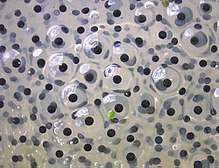Matrotrophy
Matrotrophy is a form of maternal care during embryo development.
_(21057027940).jpg)
Vegetal matrotrophy
Some flowering plants supplied the developing embryos for the first stages. The ovule has no stocks and the nutrients are provided by the "mother".
In plants, matrotrophy is considered a critical evolutionary development preceding the origin of embryophytes and therefore essential to the evolution of land plants.[1] Matrotrophy is facilitated by cytological and ultrastructural modifications on one or both sides of the generational junction, a region called the placenta.[2] Specialization of the placental cells pertains further to their cytological and ultrastructural characteristics: the cytoplasm is often dense and rich in lipids, the vacuole is typically reduced but large in Sphagnum, the endoplasmic reticulum extensive, mitochondria numerous and large, chloroplasts numerous, often less differentiated, rich in lipid-filled globuli and sometimes filled with starch.[2]
Animal matrotrophy
It is associated with live birth (viviparity), in which the embryo of an animal is supplied with additional nutrition from the mother (e.g. through an organ such as placenta or other forms of nutrients providing, e.g. ovatrophy). This can be contrasted with strict lecithotrophy as in oviparity, in which the only source of nutrition for the embryo is the yolk originally contained within the egg.
While commonly associated with vertebrates and especially mammals, matrotrophy is found in 21 of 34 animal phyla, and is fairly common in 11 of those.[3] It has arisen independently in more than 150 clades within Chordata[4] and in more than 140 clades amongst invertebrates.[3]
See also
- Pregnancy (fish)
References
- Graham, L.K.E. & Wilcox, L.W. (2000). "The origin of alternation of generations in land plants: A focus on matrotrophy and hexose transport". Philosophical Transactions of the Royal Society of London B. 355 (1398): 757–67. doi:10.1098/rstb.2000.0614. PMC 1692790. PMID 10905608.
- Ligrone, R.; Duckett, J.G.; Renzaglia, K.S. (1993). "The gametophyte-sporophyte junction in land plants". Advances in Botanical Research. 19: 231–317.
- Ostrovsky, Andrew N.; Lidgard, Scott; Gordon, Dennis P.; Schwaha, Thomas; Genikhovich, Grigory; Ereskovsky, Alexander V. (20 April 2015). "Matrotrophy and placentation in invertebrates: a new paradigm". Biological Reviews. 91 (3): 673–711. doi:10.1111/brv.12189. PMC 5098176. PMID 25925633.
- Daniel G. Blackburn (2014). "Evolution of vertebrate viviparity and specializations for fetal nutrition: A quantitative and qualitative analysis". Journal of Morphology. 276 (8): 961–990. doi:10.1002/jmor.20272.
- Goffinet B, Et al. 2009. Morphology and classification of Bryophyta. In Bryophyte Biology 2nd ed. Cambridge University Press.
